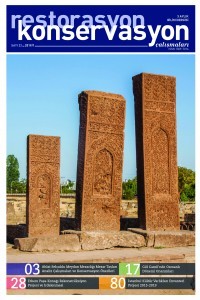Yedikule Kara Surları’nda Kullanılan Erken Bizans Dönemi Harçlarının Karakterizasyonu Üzerine Bir Araştırma
A RESEARCH ABOUT CHARACTERIZATION OF LIME MORTARS USED IN THE EARLY BYZANTINE PERIOD IN THE LAND WALLS OF CONSTANTINOPLE, YEDIKULE
___
- Ahunbay, Z., Ahunbay, M., Ersen, A., Gürdal, E., Acun, S., Güleç, A., 2003, ‘Research on the Characterization and De- terioration of the Stones, the Bricks and the Khorasan Mortars of the Tower 4 (T4) of the Land Walls of Istanbul (Cons- tantinople)’, Unpublished Fortmed Project Report submitted to project manager in Venice, EC Project no: ICA 3-CT-1999-00.
- Güleç, A., Ersen, A., 1998, ‘Characterization of Ancient Mortars: Evaluation of Simple and Sophisticated Methods’
- Journal of Architectural Conservation, Vol.4, No.1, March, pp.56-67. Güleç, A., Tulun, T., 1997, ‘Physico-Chemical and Petrographical Studies of Old Mortars and Plasters of Anatolia’, Ce- ment and Concrete Research, Vol.27, pp.227-229.
- Güleç, A., 1990, ‘Characterization of Mortars and Plasters of Some Historic Monuments, Part II’, NATO, CCMS Plot
- Study, Conservation of Historic Brick Structures, 4th Expert Meeting Proceedings Book, Amersfoort, 25-27 October 1990, pp.121
- Moropoulou, A., Bakolas, A., Moundoulas, P., 2000, ‘Criteria and Methodology for Restoration Mortars Compatib- le to the Historic Materials and Structures’, Proceedings of the 9th International Congress on Deterioration and Conservation of Stone, 24 June 2000, Venice, pp.403-411.
- Charola, A.E., Dupas, M., Shery, R.P., Freund, G.G., 1984, ‘Characterization of Ancient Mortars, Chemical and Instru- mental Methods’, Proceedings of the International Symposium on Scientific Methodologies Applied to Works of Art, Florence.
- TS 699, 1987, Standard Test Methods for Natural Stones, Türk Standartları Enstitüsü, Ankara.
- ASTM C 50, 1999, Standard Practice for Sampling, Sample Preparation, Packaging and Marking of Lime and Limestone Products, Ame- rican Standards.
- Borelli, E., 1999, ARC Laboratory Handbook, Conservation of Architectural Heritage, Historic Structures and Materials, ICCROM, Rome.
- Güleç, A., Acun, S., Ersen, A., Gürdal, E., 2003, ‘Evaluation of Konya Region Volcanic Tuff as a Pozzolanic Additive in
- Conservation Mortar’, International Symposium on Industrial Minerals and Building Stones (IMBS), Istanbul, Turkey.
- ISSN: 1309-7016
- Başlangıç: 2009
- Yayıncı: İstanbul Büyükşehir Belediyesi
Filibe Cuma Camii’nin Yapısal Restorasyonu
İşıl POLAT PEKMEZCİ, Ahmet ERSEN
Anadolu Hisarı Harçlarının Fiziko-Kimyasal ve Petrografik Özelliklerinin İncelenmesi
Dünyada "İstanbul Modeli” Olabilmek
Nilüfer BATURAYOĞLU YÖNEY, Ahmet ERSEN
Riva Kalesi Yapı Taşları, Sıva ve Harçlarının Petrografisi ve Kaynak Alanı
Bengü BAŞOL, M. Okay ŞAHİN, Mustafa BAYKIR, Gazanfer AKINCI
Süleymaniye 569 Ada 13 Parsel’de Yer Alan Ahşap Yapıda Proje Ve Uygulama
Sümeyye Meryem ARSLAN, Alidost ERTUĞRUL
Bulgaristan Filibe Cuma Camii’nin Duvar Bezemelerinin Restorasyonu
